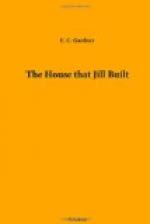“Not fully. We shall have both steam and open fires; the architect understands that, but he doesn’t know how many fireplaces nor what kind. We can tell him how many easily enough: one in each room of the first story except the kitchen, but including the hall, and one in each of the bed-rooms.”
[Illustration: “A SIMPLE RECESS.”]
“Including the guest chambers?”
“By all means. There is nothing that makes one feel so thoroughly welcome, so delightfully at home as a room with an open fire. Mahogany four-posters, velvet carpets and sumptuous fare are trivial compliments in comparison. Concerning the style and cost he says: ’Of designs there is an endless variety, and there is a wide range in cost, from the simple recess in the side of a plain brick chimney’—”
“One of the kind that Aunt Melville builds for a dollar and a quarter.”
“’—to the elaborate affairs that cost as much as a comfortable cottage. It would be idle for me to attempt to give you a full description of them all—my letter would appear like a manufacturer’s catalogue. Indeed, you can find whole books on the subject, large books too, which it will be interesting and profitable for you to study; but first it is necessary to lay out the chimneys to accommodate the sizes and styles to be chosen. You will easily understand that a grate for burning coal alone, especially hard coal, may be much smaller than a fireplace to hold hickory logs that it takes two men to carry; but the heat of anthracite coal would soon destroy the lining of a fireplace adapted to an ordinary fire of wood. It cannot be necessary to remind you that the best open fireplaces, whether for wood or coal, are those which, instead of sending three-fourths of the heat up the chimney flue, give it out from all sides, to be saved either directly or by being conveyed to an adjoining or upper room. It is also possible to make a fireplace that will accommodate either wood or coal, but like all compromises this is attended with certain disadvantages. If large enough for wood it is too large for hard coal. The smoke flue for a coal fire may also be smaller, the hotter fire causing the stronger draught. Coal ashes, too, ought to be dropped through the hearth into ash pits below, even from the fires of the upper rooms. To “take up the ashes” of a wood fire is not so troublesome. These are some of the reasons why it is necessary to determine the kind and number of your fireplaces before the plans of the chimneys are drawn.’”
[Illustration: IN THE MIDDLE RANK.]
“Why not make an appropriation of fifty dollars apiece for each grate, mantel and hearth, and have him do the best he can with it?”
“We can fix that as an average price, but shall want some better than others, and must mark in each room whether we wish to provide for wood, for coal, or for both. That is, whether we want ‘set’ grates or open fireplaces with andirons or something of that kind.”




